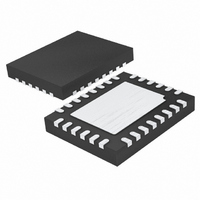LTC3850EUF#PBF Linear Technology, LTC3850EUF#PBF Datasheet - Page 24

LTC3850EUF#PBF
Manufacturer Part Number
LTC3850EUF#PBF
Description
IC CNTRLR STP DWN SYNC 28-QFN
Manufacturer
Linear Technology
Series
PolyPhase®r
Type
Step-Down (Buck)r
Datasheet
1.LTC3850EUFPBF.pdf
(38 pages)
Specifications of LTC3850EUF#PBF
Internal Switch(s)
No
Synchronous Rectifier
Yes
Number Of Outputs
2
Voltage - Output
0.8 ~ 23.3 V
Current - Output
100mA
Frequency - Switching
250kHz ~ 780kHz
Voltage - Input
4 ~ 24 V
Operating Temperature
-40°C ~ 85°C
Mounting Type
Surface Mount
Package / Case
28-QFN
Primary Input Voltage
24V
No. Of Outputs
2
Output Current
100mA
No. Of Pins
28
Operating Temperature Range
-40°C To +85°C
Msl
MSL 1 - Unlimited
Supply Voltage Range
4V To 24V
Rohs Compliant
Yes
Lead Free Status / RoHS Status
Lead free / RoHS Compliant
Power - Output
-
Available stocks
Company
Part Number
Manufacturer
Quantity
Price
LTC3850/LTC3850-1
APPLICATIONS INFORMATION
Although all dissipative elements in the circuit produce
losses, four main sources usually account for most of the
losses in LTC3850 circuits: 1) IC V
regulator current, 3) I
transition losses.
1. The V
2. INTV
3. I
24
the Electrical Characteristics table, which excludes
MOSFET driver and control currents. V
cally results in a small (<0.1%) loss.
control currents. The MOSFET driver current results
from switching the gate capacitance of the power
MOSFETs. Each time a MOSFET gate is switched from
low to high to low again, a packet of charge dQ moves
from INTV
rent out of INTV
control circuit current. In continuous mode, I
= f(Q
the topside and bottom side MOSFETs.
Supplying INTV
put-derived source will scale the V
for the driver and control circuits by a factor of (Duty
Cycle)/(Efficiency). For example, in a 20V to 5V applica-
tion, 10mA of INTV
2.5mA of V
from 10% or more (if the driver was powered directly
from V
fuse (if used), MOSFET, inductor, current sense resistor.
In continuous mode, the average output current flows
through L and R
topside MOSFET and the synchronous MOSFET. If the
two MOSFETs have approximately the same R
then the resistance of one MOSFET can simply be
summed with the resistances of L and R
I
= 10mΩ, R
25mΩ. This results in losses ranging from 2% to 8%
as the output current increases from 3A to 15A for
a 5V output, or a 3% to 12% loss for a 3.3V output.
Efficiency varies as the inverse square of V
same external components and output power level. The
combined effects of increasingly lower output voltages
2
2
R losses are predicted from the DC resistances of the
R losses. For example, if each R
CC
T
IN
+ Q
IN
current is the sum of the MOSFET driver and
) to only a few percent.
current is the DC supply current given in
B
CC
IN
), where Q
SENSE
current. This reduces the mid-current loss
to ground. The resulting dQ/dt is a cur-
CC
CC
SENSE
= 5mΩ, then the total resistance is
that is typically much larger than the
power through EXTV
CC
2
T
R losses, 4) Topside MOSFET
current results in approximately
, but is “chopped” between the
and Q
B
are the gate charges of
IN
DS(ON)
IN
current, 2) INTV
current required
CC
IN
SENSE
current typi-
= 10mΩ, R
from an out-
OUT
to obtain
GATECHG
DS(ON)
for the
CC
L
,
Other “hidden” losses such as copper trace and internal
battery resistances can account for an additional 5% to
10% efficiency degradation in portable systems. It is very
important to include these “system” level losses during
the design phase. The internal battery and fuse resistance
losses can be minimized by making sure that C
adequate charge storage and very low ESR at the switch-
ing frequency. A 25W supply will typically require a
minimum of 20µF to 40µF of capacitance having
a maximum of 20mΩ to 50mΩ of ESR. The LTC3850
2-phase architecture typically halves this input capacitance
requirement over competing solutions. Other losses
including Schottky conduction losses during dead time
and inductor core losses generally account for less than
2% total additional loss.
Checking Transient Response
The regulator loop response can be checked by looking at
the load current transient response. Switching regulators
take several cycles to respond to a step in DC (resistive)
load current. When a load step occurs, V
amount equal to ∆I
series resistance of C
discharge C
forces the regulator to adapt to the current change and
return V
time V
ringing, which would indicate a stability problem. The
availability of the I
control loop behavior but also provides a DC coupled and
AC filtered closed loop response test point. The DC step,
rise time and settling at this test point truly reflects the
closed loop response. Assuming a predominantly second
order system, phase margin and/or damping factor can be
estimated using the percentage of overshoot seen at this
4. Transition losses apply only to the topside MOSFET(s),
and higher currents required by high performance digital
systems is not doubling but quadrupling the importance
of loss terms in the switching regulator system!
and become significant only when operating at high
input voltages (typically 15V or greater). Transition
losses can be estimated from:
Transition Loss = (1.7) V
OUT
OUT
can be monitored for excessive overshoot or
OUT
to its steady-state value. During this recovery
generating the feedback error signal that
TH
LOAD
OUT
pin not only allows optimization of
(ESR), where ESR is the effective
. ∆I
IN
LOAD
2
I
O(MAX)
also begins to charge or
C
RSS
OUT
f
shifts by an
IN
38501fc
has













